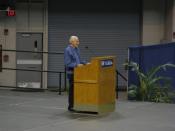One of the most important public policy debates today surrounds the issues of euthanasia and assisted suicide. The outcome of that debate will profoundly affect family relationships, interaction between doctors and patients, and concepts of basic ethical behavior. With so much at stake, more is needed than a duel of one-liners, slogans and sound bites.
One way to distinguish euthanasia and assisted suicide is to look at the last act - the act without which death would not occur.
Using this distinction, if a third party performs the last act that intentionally causes a patient's death, euthanasia has occurred. For example, giving a patient a lethal injection or putting a plastic bag over her head to suffocate her would be considered euthanasia.
On the other hand, if the person who dies performs the last act, assisted suicide has taken place. Thus it would be assisted suicide if a person swallows an overdose of drugs that has been provided by a doctor for the purpose of causing death.
It would also be assisted suicide if a patient pushes a switch to trigger a fatal injection after the doctor has inserted an intravenous needle into the patient's vein.
Modern medicine has definitely lengthened life spans. A century ago, high blood pressure, pneumonia, appendicitis, and diabetes likely meant death, often accompanied by excruciating pain. Women had shorter life expectancies than men since many died in childbirth. Antibiotics, immunizations, modern surgery and many of today's routine therapies or medications were unknown then.
A lot of people think that euthanasia or assisted suicide is needed so patients won't be forced to remain alive by being "hooked up" to machines. But the law already permits patients or their surrogates to withhold or withdraw unwanted medical treatment even if that increases the likelihood that the patient will...


